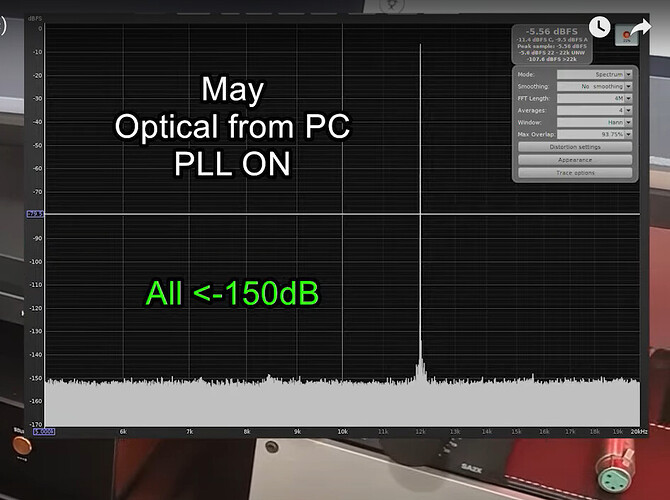I lost interest the moment he said ‘this video is not about whether the differences you see in the graphs are audible or not’…
I checked it out. All the measurements are looking at Holo May DAC with it’s PLL turned off.
He never shows the measurement with PLL turned on till the very end and no surprise, it is the best measurement in the entire video.
So a great DAC with electrically isolated input (with PLL turned on like its supposed to) made the source jitter irrelevant, as expected
When you Follower the video I am sure you noticed as well that it’s not just jitter but also noise which has an impact.
Yes, I watched the whole thing, several months ago. What I remember is that he really really liked the Pi2AES as a buffer between the source and the DAC.
There’s no noise with optical - it’s just light.
For USB, I can highly recommend Intona isolators, especially newest range (USB2 model is enough for DACs) - no noise and no electrical connection to USB source.
Many USB DACs have USB galvanic isolation but when you look closely, the isolation comes after the USB input stage… There’s only a handful that I know that have USB isolation right at the input, not after.
That’s where an Intona isolator can come in handy, if one is really worried about USB
source noise.
GoldenSound uses an Intona also now
Of course there’s opportunity for noise with optical – it’s optical noise, caused by refraction and reflection, instead of electrical noise.
What’s more, introducing medium changers – electrical to optical and then optical back to electrical – introduces even more opportunity for noise and distortion. The fewer medium shifts, the better, would be my thinking.
The saving grace is that digital doesn’t care. Noise on the medium doesn’t usually distract from correct transport of the precious bits.
What does that mean exactly? Isn’t it still in the digital domain?
Assuming it passes bit perfect test, per thread title, then those things don’t matter… I’d forgotten to start my sentence with “assuming bit perfect transfer”
My sentence you partially quoted started mentioned USB DACs - these convert digital to analogue. When talking about isolation, obviously talking about ground noise/currents/RF… So no ![]()
For added context look at the screenshot I showed. Holo May is a DAC btw
I don’t understand what you mean by the isolator being after the USB stage. What is the stage after the isolator? Are USB isolators different? Where do those have the isolator?
You are confusing USB DACs with USB galvanic isolation and standalone USB isolators.
Have a re-read of my post above.
Then go look at various USB DACs which have built-in isolators, and look where the USB isolation is located. And maybe how the isolation is powered. And then have a think about if that is the optimal location to isolate from USB source ground noise/currents/RF.
I was hoping you’d tell me that, since you mentioned it. I would think that the isolation is located before the D/A conversion stage, so it would still be in the digital domain of the signal path inside the DAC. Otherwise, I don’t know what it would isolate from what.
Somewhere sometime I recall you mentioned you’re an electrical engineer. You can work it out !
Ground noise/currents/RF don’t just belong to digital domain.
You have to look at electrical pathways through the DAC. Have a look at insides of DACs
(Obviously having balanced analogue outputs greatly minimise these issues technical issues becoming audible)
I am a physicist by education and a software engineer by profession. Signal processing and audio engineering are just my hobbies. When I don’t know something, I ask people who know more than me in this forum, hoping to learn something new and to be corrected when I’m wrong. You seem to be unwilling or unable to do that, so I guess I’ll look somewhere else.
It’s just not bits are bits…you can have bit perfect data transfer and still get noise and jitter that affect the analog signal coming out of the DAC. Period!
That’s absolutely true! And I guess it would be nice if this gets more widely recognized among users.
Interesting to see that industry vendors over the last years are also increasingly improving their products in this regard.
It really IS bits are bits, decoding the perfect signal is trivial outside of extreme environments. While streaming music presents some challenges they’re not extreme in a data bandwidth/integrity sense. Noise and jitter CAN affect a particular DAC’s output, but they’re engineering issues for the designer to solve. Think about it, you can’t do better than bit-perfect delivery to the DAC which is a solved problem. Optimal analogue reproduction from that point is surely the DAC builders problem and shouldn’t require the customer to effectively buy better digital inputs.
That was never a problem in the first place. Bit perfect has always been there.
That’s correct. But, in the real world, it has been a problem since the beginning.
Aren’t all these DDCs in the real world? Why can those do miracles that DACs can’t? You can get a DAC, connect it to isolators, re-clockers, and anything else you think it’s going to improve performance, then get a big box, put everything in it and write “DAC” on it. You got yourself a good DAC in the real world.
Or, get a DAC that already does all these things in one relatively small chassis. A few hundred dollars should cover it.
DACs can do this but most do not…even today. My DAC, the Holo Audio May KTE, does a great job of cleaning up electrical noise and jitter. It’s USB interface is fantastic at this and is what I use as an input.
